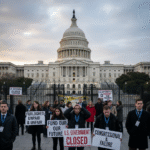
The United States government officially entered a partial shutdown at 12:01 a.m. EDT on October 1, 2025, after Congress failed to approve a funding bill for the 2026 fiscal year. The impasse stemmed from partisan disagreements over federal spending levels, foreign aid, and health insurance subsidies.
Approximately 900,000 federal employees have been furloughed, while another 700,000 continue to work without pay. Critical government agencies, including the National Institutes of Health (NIH), the Centers for Disease Control and Prevention (CDC), and the Women, Infants, and Children (WIC) program, face partial or full suspensions of operations, affecting public health services and ongoing research initiatives.
The shutdown has also impacted financial markets. Investors have moved towards safe-haven assets, causing the U.S. dollar to dip to a one-week low and driving gold prices to record highs. Economic analysts warn that prolonged funding gaps could slow economic growth and disrupt global trade.
Politically, the shutdown has deepened partisan tensions. President Trump has threatened permanent job cuts and criticized Democrats for obstructing the funding process. Meanwhile, congressional leaders continue negotiations to reach a compromise and restore full government operations.
As the situation develops, millions of Americans remain uncertain about government services, while financial markets and federal employees brace for the potential fallout of an extended shutdown.
